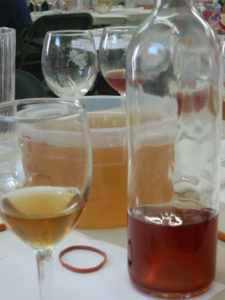 A few days ago it was National Mead Day! If you don’t know what mead is, well, get ready for something sweet. Mead’s (honey wine) most well known by Americans as the fuel behind the berserker rage of marauding Vikings.
A few days ago it was National Mead Day! If you don’t know what mead is, well, get ready for something sweet. Mead’s (honey wine) most well known by Americans as the fuel behind the berserker rage of marauding Vikings.
In reality, Mead is one of the oldest beverages created by man. Not surprising really since mead just blends honey and water. The diluted syrup loses most of honey’s natural antibiotic properties. Natural yeast easily takes foothold and goes to work producing a strong wine that retains the honey’s flower and spicy qualities.
Your local good beer store will have a limited amount of mead available for the tasting. The most commonly available on will be from Redstone Meadery of Colorado. Avoid the typical Irish/English “Meade” found in some wine stores. These are typically nothing more than white wine blended with honey.
Fortunately mead is extremely easy and quick to make. All you need is some honey, some yeast nutrient and some yeast. For the best quality mead, you need to start with high quality honey. Check out the Farmer’s markets for good local sources of honey. Colton, CA contains one of the area’s largest honey suppliers, Miller’s Honey.
For each gallon of mead you’ll need 2.5-3.6 lbs of honey. In volume, that equates to 26oz-38.5oz. Honey’s heavy stuff!
When I make mead, I do it 5 gallon batches. I heat 1 gallon of water and blend 12-18lbs of honey into the hot water. I add the honey water to my carboy/bucket and top up to 5 gallons (takes roughly 2.5-3 gallons of cold water). I add an 1/4 TBSP of yeast nutrient and shake/swirl the carboy to mix the honey and water. While that’s going on, I rehydrate 2 packages of dry Cotes d’Blanc White Wine yeast. Once it’s nice and foamy, it’s straight into the mead and close it up until the next morning. For the next 3 days I add another 1/4 TBSP of nutrient twice a day.
One month later, the mead should be done actively fermenting. Sanitize a smaller carboy and your racking cane. Carefully transfer the mead to avoid the yeast and protein on the bottom. Close it up and let it sit for a while. Oh and make sure to take a taste!
After another month or two, santize a bunch of wine bottles and corks (or beer bottles and caps), transfer the mead to a bottling bucket and dispense into your bottles of choice. Seal up and wait at least another month.
Congratulations, you now have your very first mead. And really, it only took an hour or so of active work! Look online and you’ll be able to find recipes that incorporate spices, fruit, vegetables and more .
Standard Mead:
For 5 gallons
12-18 lbs Honey (less for a drier mead, more for sweeter, stronger)
3.5-4 gallons Clean Carbone Filtered Water (No straight tap water!)
2 TBSP Yeast Nutrient
2 packages Cotes d’Blanc dried White Wine Yeast
Hope the above got you salivating for some mead! I certainly plan on making a fair amount this year and will update you on how that goes!
Happy wine (mead) making….
Article by: Drew Beechum
